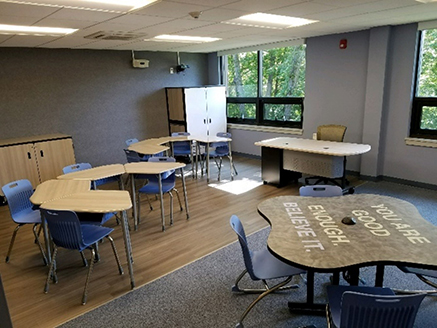Mobility in the classroom is critical to the success of the four C’s of learning:
Communication
Collaboration
Critical Thinking
Creativity
All students do not learn the same, so collaborative learning spaces that are flexible and adaptive put students in a position to succeed academically, socially, and emotionally.
Classroom design is a powerful tool for improving the levels of student interaction and engagement. Active learning and flexible classrooms lead to improved retention, increased test score results and decreased interference because each student can learn the way they individually need to. Students are more successful when they feel empowered to choose the micro-environment that fits their individual learning style.
Here are some tips that PARsolutions would follow when creating a high-functioning Mobile Classroom:
- Easily changing furniture arrangements leads to more engaged students that have higher participation and more in-depth conversations.
- Sit-to-stand desks and tables on caster wheels give choice and flexibility to the student. Choice empowers and provides students with a sense of pride and responsibility in their own decision-making skills.
- Offer three or four types of seating options (per classroom) that students can choose how and where they want to sit so they can focus and perform better. From laying on the floor to standing or sitting in a rocking chair or perch — the options have been created to help children learn.
- Marker Boards that allow for brainstorming and collaboration. If budget (and room) allows, an entire wall can be dedicated as a white board; or, a mobile storage easel with individual boards can also do the trick!
- Incorporate “Think Nooks” that support healthy transitions between group work and individualized learning. This mobile piece is the perfect solution for students who need quiet time to think, transition, read or simply reset their intentions.
- Incorporate Inspirational mottos into the walls and furniture surfaces to motivate, inspire and reinsure students that they can and will be successful if they consistently try their best.

PARsolutions uses a unique formula when designing environments…
we LISTEN to the teachers +
we OBSERVE the students +
we STRECH the budget dollars
…creating a flexible environment that will be adaptive to all types of learners. How can we help move your initiatives forward? We are listening and ready to assist you with your classroom needs.
Supporting Evidence:
1: A 2012 study from the University of Minnesota found that students participated 48 percent more in discussions in a classroom with collaborative group seating versus traditional lecture-style seating, and also improved their performance on standardized tests. As republished by Smith Systems.
2: MDR, a Dun and Bradstreet division, compiled their insights from a study on The Impact of Learning Spaces on Student Success shows that 69% would like spaces that are OPEN, FLEXIBLE, and COLLABORATIVE and 65% would value flexible furniture in the K – 8 environment and 53% in the high school. 86% see value in increased physical movement in learning style accommodations.